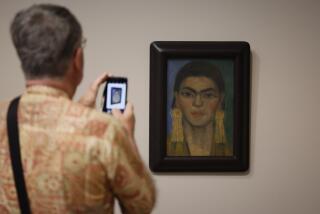How the Obama portraits cheerfully buck the trend of instantly forgettable presidential paintings
Video killed the radio star, but, save for a few exceptions, photography killed presidential portrait painters.
As painting genres go, presidential portraiture was, if only for a few decades, the only way our head of state’s visage could be recorded and interpreted for posterity. Now, U.S. presidents (and their wives) are among the most photographed people on the planet, supplanting most traditional reasons for painting a world leader’s likeness in the first place.
On Tuesday, his-and-her painted portraits of Barack and Michelle Obama, commissioned by the Smithsonian Institution, went on public view at the National Portrait Gallery in Washington, D.C. They cheerfully buck the official portrait trend of instantly forgettable painterly pablum.
His was painted by L.A.-born, New York-based Kehinde Wiley, 40; hers was painted by Baltimore-based Amy Sherald, 44, who was born in Columbus, Georgia. These are not the official portraits that will some day hang in the White House but a separate set — his destined for the gallery’s permanent “Hall of Presidents” display, hers for the museum’s collection.
Like almost everyone, I’ve only seen the paintings in reproduction, which isn’t really good enough for a full accounting. Reproductions don’t convey accurate color or texture, and they erase the essential dynamism of scale. (The president’s canvas is seven feet tall, which suggests a certain larger-than-life environment in relation to a viewer). Paintings also live or die on surface qualities of reflected light, while reproductions are today typically juiced by light projected through the image on a mobile or desktop digital screen.
Reproductions peel off a painting’s complex formalism, leaving behind composition and iconography as the bare bones with which to read the work as a disembodied image. Wiley and Sherald had a lot to work with in that regard. They’re the first African American artists to receive such a commission, and they are representing the first African Americans to occupy the White House – which was built with slave labor.
The dress in Sherald’s portrait of the former first lady, whose wardrobe during her White House tenure was carefully watched for its fresh and distinctly contemporary style, was always going to be a lightning rod. Astutely, the artist made it a centerpiece.
The halter-top dress is by American designer Michelle Smith of the label, Milly, whose clothes have often been worn by Obama. For the seated portrait, the dress forms a voluminous white mountain, on top of which Michelle Obama’s exposed arms, shoulders and elegantly posed head, hair loose and unfurled, securely rest.
Unsmiling, she looks you squarely in the eye.
Her skin is depicted in Sherald’s trademark gray-scale – a device reminiscent of black-and-white photography that the artist has long used for portraiture. The aim is to “exclude the idea of color as race,” she has said. In the Obama portrait, color is located most effusively in the sky-blue field in which the “mountain” resides. Obama is at once Olympian and down to earth.
Color also erupts in the geometric patterns that decorate the dress, which the designer has been quick to note is not couture. (Forget velvet or brocade; the material is stretch cotton.) The black-and-white patterns do recall the famous quilt designs produced by generations of African American women in the Alabama hamlet of Gee’s Bend, as Sherald has also said. But the repeated pattern of multicolored horizontal bars also evokes the radical 1920s textiles of German Bauhaus artist, Anni Albers.
Albers, like other women of her day, was kept from becoming a painter, so she channeled her extraordinary talents into revolutionizing woven fabrics. Obama is wrapped in — and lofted by — imagery created by pioneering women.
Wiley embeds the president, dressed in a casual Friday dark suit with an open-collar white shirt, within a vertical field of bright green foliage dotted with red, gold, orange and violet flowers. The design may be simple realism, but it ricochets between royal tapestry and homey wallpaper, which the artist has used in other paintings.
Leaves coil around the president’s feet, cushioning the legs of the refined, antique wooden chair on which he sits. The president leans forward slightly, arms loosely crossed on his knees.
Surely the composition nods to the seated portrait of Abraham Lincoln by George P.A. Healy, the most celebrated (if now little known) American portraitist of the Civil War era. In 1868, Healy rendered Lincoln’s posthumous portrait in a history painting, “The Peacemakers,” showing a crucial meeting in Richmond, Va., with Generals Ulysses S. Grant and William Tecumseh Sherman and Admiral David Dixon Porter during the war’s final days. With a sentimental flourish typical of its day, the artist added an optimistic rainbow outside the window framing Lincoln’s head.
Healy painted more than one version of the scene, attesting to the work’s popularity, as well as a separate Lincoln portrait seated in the same wooden chair. Obama installed one of them, acquired in 1947 for the White House art collection, in the Oval Office dining room.
Like the first lady in Sherald’s painting, the president in Wiley’s does not smile, instead offering a penetrating stare. Obama, the veritable picture of self-restraint, is a New Adam in a lush and visually tumultuous modern Eden.
Wiley’s work often makes fun of the overblown pomp-and-circumstance of European Old Master art. This painting is certainly vivid and unusual, but he’s toned it down from the florid regalia of uniformed pageantry his portraits often employ. He has identified the flowers in his landscape as symbols of places meaningful to the president — Hawaii (jasmine), Kenya (African lilies), Chicago (chrysanthemums, the city’s official flower).
Racists on social media have been quick to decry the artists as “affirmative action” hires, a repulsive if unsurprising slur in our reactionary period of white backlash. Even some mainstream outlets, such as the Hollywood news and gossip site the Wrap, have gone for inflammatory clickbait, trolling the artists and courting dwellers in the alt-right fever-swamp.
Needless to say, Obama’s predecessor, George W. Bush, didn’t suffer the same assault when he chose Robert Anderson, a Yale classmate and bland Connecticut portraitist, for his nondescript likeness. (Anderson’s pastel illustrations have appeared in print advertising for Breck shampoo.) Kimberly Drew, social media manager at New York’s Metropolitan Museum of Art, aptly noted on Twitter (@museummammy) that both Wiley and Obama have dedicated their careers to “revising how the world sees black people” — a project that certainly riles the insecure.
Out across the land, a culture war is raging. It’s the source of the unprecedented public response to this Smithsonian commission, which far surpasses the unveiling of any presidential portrait before it. Even in reproductions it’s easy — and encouraging — to see that the Obamas, Wiley and Sherald have not shied away.
In the White House, the Obamas were the first of their kind. At the Smithsonian, the artists are the first of their kind. And in the annals of official American portraiture, these paintings are the first of their kind. They will not be the last.
More to Read
The biggest entertainment stories
Get our big stories about Hollywood, film, television, music, arts, culture and more right in your inbox as soon as they publish.
You may occasionally receive promotional content from the Los Angeles Times.











